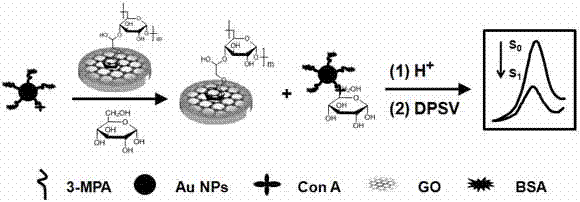Non-enzymatic electrochemical bio-sensing method facilitating glucose detection
A technology for biosensing and glucose, applied in the field of bioelectrochemical sensing, can solve the problems of electrochemical electrical signal interference, complex preparation method and high analysis cost, and achieve the effects of low detection cost, overcoming complex preparation method and high sensitivity
- Summary
- Abstract
- Description
- Claims
- Application Information
AI Technical Summary
Problems solved by technology
Method used
Image
Examples
Embodiment 1
[0019] Embodiment 1 A non-enzymatic electrochemical biosensing method for conveniently detecting glucose, comprising the following steps:
[0020] (1) Preparation of electrochemical sensors
[0021] 1.8 μL of 1 mg / mL graphene oxide dispersion was added dropwise to the surface of the working electrode of the screen-printed carbon electrode, dried at room temperature and then transferred to Tris-HCl with a concentration of 50 mM pH=6.5, using the potentiostatic electrochemical reduction method, That is, the potential is -1.2V, the scanning rate is 100mV / s, and the time is 600s. The graphene oxide is converted into reduced graphene, washed with water and dried at room temperature to obtain the reduced graphene modified electrode; 2.0 μL of a 10 mM pH=7.4 Tris-HCl solution with a concentration of 3.0 μM phenyl-dextran was added dropwise to the surface of the alkene-modified electrode, washed at 37 °C for 2 h, washed and dried, and stored in a dry environment at 4 °C for later use....
Embodiment 2
[0024] Example 2 Detection of glucose content in standard solution
[0025] A mixed solution containing 20 μL of Au NP-Con A nanoprobe and 10 μL of glucose standard solution was added dropwise to the prepared sensor surface. After dynamic incubation at 37°C for 30min, 50mM pH=7.0 Tris-HCl / Tween-20 solution and Tris-HCl solution were used to wash and dry, and then 30μL of 0.1mol / L HCl solution was added dropwise, and pre-oxidized at 1.3V constant potential Immediately after 40s, the current response value was recorded by differential pulse voltammetry (DPV) in the range of 0.5-0V, so as to detect the content of glucose in the standard solution. The working curve of the obtained glucose standard solution is shown in Table 1 below.
[0026] Table 1 Working curve of glucose standard solution
[0027] Detector
Embodiment 3
[0028] Example 3 Detection of glucose content in human serum
[0029] Three clinical serum samples were taken, and five parallel tests were carried out for each sample. The processing method of the samples was the same as the above-mentioned standard solution. The concentration of glucose in the detected samples was shown in Table 2 below. The above-mentioned three clinical serum samples were analyzed by hospital commercialization. The measurement results of the instrument (Abbott C8000 automatic biochemical analyzer) are compared, and the results are shown in Table 2 below.
[0030] Table 2 Comparison of the measurement results of the present embodiment and the hospital commercialized analytical instrument
[0031] Sample serial number
[0032]As can be seen from Table 2 above, the relative standard deviation (RSD) of the test results of this embodiment is 4.9-6.7%, and the relative error is -3.9-6.4%, indicating that the analysis method of this embodiment has high ...
PUM
| Property | Measurement | Unit |
|---|---|---|
| molecular weight | aaaaa | aaaaa |
Abstract
Description
Claims
Application Information
 Login to View More
Login to View More - R&D
- Intellectual Property
- Life Sciences
- Materials
- Tech Scout
- Unparalleled Data Quality
- Higher Quality Content
- 60% Fewer Hallucinations
Browse by: Latest US Patents, China's latest patents, Technical Efficacy Thesaurus, Application Domain, Technology Topic, Popular Technical Reports.
© 2025 PatSnap. All rights reserved.Legal|Privacy policy|Modern Slavery Act Transparency Statement|Sitemap|About US| Contact US: help@patsnap.com



